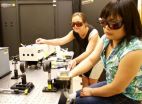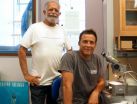(Press-News.org) WEST LAFAYETTE, Ind. — Spinach gave Popeye super strength, but it also holds the promise of a different power for a group of scientists: the ability to convert sunlight into a clean, efficient alternative fuel.
Purdue University physicists are part of an international group using spinach to study the proteins involved in photosynthesis, the process by which plants convert the sun's energy into carbohydrates used to power cellular processes.
"The proteins we study are part of the most efficient system ever built, capable of converting the energy from the sun into chemical energy with an unrivaled 60 percent efficiency," said Yulia Pushkar, a Purdue assistant professor of physics involved in the research. "Understanding this system is indispensible for alternative energy research aiming to create artificial photosynthesis."
During photosynthesis plants use solar energy to convert carbon dioxide and water into hydrogen-storing carbohydrates and oxygen. Artificial photosynthesis could allow for the conversion of solar energy into renewable, environmentally friendly hydrogen-based fuels.
In Pushkar's laboratory, students extract a protein complex called Photosystem II from spinach they buy at the supermarket. It is a complicated process performed over two days in a specially built room that keeps the spinach samples cold and shielded from light, she said.
Once the proteins have been carefully extracted, the team excites them with a laser and records changes in the electron configuration of their molecules.
"These proteins require light to work, so the laser acts as the sun in this experiment," Pushkar said. "Once the proteins start working, we use advanced techniques like electron paramagnetic resonance and X-ray spectroscopy to observe how the electronic structure of the molecules change over time as they perform their functions."
Photosystem II is involved in the photosynthetic mechanism that splits water molecules into oxygen, protons and electrons. During this process a portion of the protein complex, called the oxygen-evolving complex, cycles through five states in which four electrons are extracted from it, she said.
The international team recently revealed the structure of the first and third states at a resolution of 5 and 5.5 Angstroms, respectively, using a new technique called serial femtosecond crystallography. A paper detailing the results was published in Nature and is available online. In addition to Pushkar, Purdue postdoctoral researcher Lifen Yan and former Purdue graduate student Katherine Davis participated in the study and are paper co-authors.
Petra Fromme, professor of chemistry and biochemistry at Arizona State University, leads the international team.
"The trick is to use the world's most powerful X-ray laser, named LCLS, located at the Department of Energy's SLAC National Accelerator Laboratory," said Fromme in a statement. "Extremely fast femtosecond (one-quadrillionth of a second) laser pulses record snapshots of the PSII crystals before they explode in the X-ray beam, a principle called 'diffraction before destruction.'"
While X-ray crystallography reveals structural changes, it does not provide details of how the electronic configurations evolve over time, which is where the Purdue team's work came in. The Purdue team mimicked the conditions of the serial femtosecond crystallography experiment, but used electron paramagnetic resonance to reveal the electronic configurations of the molecules, Pushkar said.
"The electronic configurations are used to confirm what stage of the process Photosystem II is in at a given time," she said. "This information is kind of like a time stamp and without it the team wouldn't have been able to put the structural changes in context."
INFORMATION:
The National Science Foundation and Department of Energy funded the Purdue team's work.
Writer: Elizabeth Gardner, 765-494-2081, ekgardner@purdue.edu
Source: Yulia Pushkar, 765-496-3279, ypushkar@purdue.edu
ASU news release:
https://asunews.asu.edu/20140709-water-splitting-photosynthesis
ABSTRACT
Serial time-resolved crystallography of photosystem II using a femtosecond X-ray laser
Names of researchers who wrote the article (format is "Abstract-AUTHORS") Christopher Kupitz, Shibom Basu, Ingo Grotjohann, Raimund Fromme, Nadia A. Zatsepin, Kimberly N. Rendek,
Mark S. Hunter, Robert L. Shoeman, Thomas A. White, Dingjie Wang, Daniel James, Jay-How Yang, Danielle E. Cobb, Brenda Reeder, Raymond G. Sierra, Haiguang Liu, Anton Barty, Andrew L. Aquila, Daniel Deponte, Richard A. Kirian, Sadia Bari, Jesse J. Bergkamp, Kenneth R. Beyerlein, Michael J. Bogan, Carl Caleman, Tzu-Chiao Chao,
Chelsie E. Conrad, Katherine M. Davis, Holger Fleckenstein, Lorenzo Galli, Stefan P. Hau-Riege, Stephan Kassemeyer, Hartawan Laksmono, Mengning Liang, Lukas Lomb, Stefano Marchesini, Andrew V. Martin, Marc Messerschmidt, Despina Milathianaki, Karol Nass, Alexandra Ros, Shatabdi Roy-Chowdhury, Kevin Schmidt, Marvin Seibert,
Jan Steinbrener, Francesco Stellato, Lifen Yan, Chunhong Yoon, Thomas A. Moore, Ana L. Moore, Yulia Pushkar,
Garth J. Williams, Se ́bastien Boutet, R. Bruce Doak, Uwe Weierstall, Matthias Frank, Henry N. Chapman,
John C. H. Spence & Petra Fromme
Photosynthesis, a process catalysed by plants, algae and cyanobacteria converts sunlight to energy, thus sustaining all higher life on Earth. Two large membrane protein complexes, photosystem I and II (PSI andPSII), act in series to catalyse the light-driven reactions in photosynthesis. PSII catalyses the light-driven water splitting process, which maintains the Earth's oxygenic atmosphere. In this process, the oxygen-evolving complex (OEC) of PSII cycles through five states, S0 to S4, in which four electrons are sequentially extracted from the OEC in four light-driven charge separation events. Here we describe time resolved experiments on PSII nano/microcrystals from Thermosynechococcus elongates performed with the recently developed technique of serial femtosecond crystallography. Structures have been determined from PSII in the dark S1 state and after double laser excitation (putative S3 state) at 5 and 5.5. Å resolution, respectively. The results provide evidence that PSII undergoes significant conformational changes at the electron acceptor side and at the Mn4CaO5 core of the OEC. These include an elongation of the metal cluster, accompanied by changes in the protein environment, which could allow for binding of the second substrate water molecule between the more distant protruding Mn (referred to as the 'dangler' Mn) and the Mn3CaOx cubane in the S2 to S3 transition, as predicted by spectroscopic and computational studies. This work shows the great potential for time-resolved serial femtosecond crystallography for investigation of catalytic processes in biomolecules.
Spinach could lead to alternative energy more powerful than Popeye
2014-07-23
ELSE PRESS RELEASES FROM THIS DATE:
The birth of topological spintronics
2014-07-23
The discovery of a new material combination that could lead to a more efficient approach to computer memory and logic will be described in the journal Nature on July 24, 2014. The research, led by Penn State University and Cornell University physicists, studies "spin torque" in devices that combine a standard magnetic material with a novel material known as a "topological insulator." The team's results show that such a scheme can be 10 times more efficient for controlling magnetic memory or logic than any other combination of materials measured to date.
"This is a really ...
Strategy proposed for preventing diseases of aging
2014-07-23
AUDIO:
Some researchers are proposing that changing how medical care is delivered could help prevent multiple chronic diseases and extend healthy lifespan. The idea, they argue, would be to target the...
Click here for more information.
Medicine focuses almost entirely on fighting chronic diseases in a piecemeal fashion as symptoms develop. Instead, more efforts should be directed to promoting interventions that have the potential to prevent multiple chronic diseases and extend ...
Sleep deprivation may increase susceptibility to false memories
2014-07-23
Not getting enough sleep may increase the likelihood of forming false memories, according to research published in Psychological Science, a journal of the Association for Psychological Science.
In a study conducted by psychological scientist Steven J. Frenda of the University of California, Irvine and colleagues, sleep-deprived people who viewed photographs of a crime being committed and then read false information about the photos were more likely to report remembering the false details in the photos than were those who got a full night's sleep.
Research has demonstrated ...
Satellite shows Atlantic Tropical Depression degenerate
2014-07-23
NOAA's GOES-East satellite captured imagery of the Atlantic Ocean's Tropical Depression 2 is it degenerated into a tropical wave on July 23.
At 1445 UTC (10:45 a.m. EDT), NOAA's GOES-East satellite captured an image of what was once Tropical Depression 2 (TD2), about 400 miles east of the Lesser Antilles. The GOES-East visible satellite imagery indicated that the depression weakened since July 22. TD2 appeared as just a weak swirl of clouds with no strong thunderstorms or deep convection. The GOES image was created by NASA/NOAA's GOES Project at NASA's Goddard Space Flight ...
Gene inhibitor, salmon fibrin restore function lost in spinal cord injury
2014-07-23
Irvine, Calif., July 23, 2014 — A therapy combining salmon fibrin injections into the spinal cord and injections of a gene inhibitor into the brain restored voluntary motor function impaired by spinal cord injury, scientists at UC Irvine's Reeve-Irvine Research Center have found.
In a study on rodents, Gail Lewandowski and Oswald Steward achieved this breakthrough by turning back the developmental clock in a molecular pathway critical to the formation of corticospinal tract nerve connections and providing a scaffold so that neuronal axons at the injury site could grow ...
Fires in the Northern Territories July 2014
2014-07-23
Environment Canada has issued a high health risk warning for Yellowknife and surrounding area because of heavy smoke in the region due to forest fires. In the image taken by the Aqua satellite, the smoke is drifting eastward along normal wind patterns. Fire is an obvious health hazard, but the smoke that comes from fires is not quite so obvious and its effects are insidious.
The smoke released by any type of fire (forest, brush, crop, structure, tires, waste or wood burning) is a mixture of particles and chemicals produced by incomplete burning of carbon-containing ...
Study links enzyme to autistic behaviors
2014-07-23
RIVERSIDE, Calif. — Fragile X syndrome (FXS) is a genetic disorder that causes obsessive-compulsive and repetitive behaviors, and other behaviors on the autistic spectrum, as well as cognitive deficits. It is the most common inherited cause of mental impairment and the most common cause of autism.
Now biomedical scientists at the University of California, Riverside have published a study that sheds light on the cause of autistic behaviors in FXS. Appearing online today (July 23) in the Journal of Neuroscience, and highlighted also on the cover in this week's print issue ...
This week from AGU: New Oso report, rockfall in Yosemite, and earthquake models
2014-07-23
From AGU's blogs: Oso disaster had its roots in earlier landslides
A research team tasked with being some of the first scientists and engineers to evaluate extreme events has issued its findings on disastrous Oso, Washington, landslide. The report studies the conditions and causes related to the March 22 mudslide that killed 43 people and destroyed the Steelhead Haven neighborhood in Oso, Washington. The team from the Geotechnical Extreme Events Reconnaissance (GEER) Association, funded by the National Science Foundation, determined that intense rainfall in the three ...
York University researchers use bird 'backpacks' to put wood thrushes migration on the map
2014-07-23
TORONTO, July 23, 2014 – Migratory songbirds are disappearing, and though conservationists are examining several possible reasons such as climate change, loss of habitat, acid rain and light pollution, a key piece of the puzzle has remained missing: where do these birds go once they leave their breeding sites, and what threats may they be encountering along the way?
To answer this question, a team of researchers out of York University have created the first ever migratory connectivity map produced for a songbird, using tracking from both breeding and winter sites. They ...
Diseases of another kind
2014-07-23
The drought that has the entire country in its grip is affecting more than the color of people's lawns. It may also be responsible for the proliferation of a heat-loving amoeba commonly found in warm freshwater bodies, such as lakes, rivers and hot springs, which the drought has made warmer than usual this year.
A 9-year-old Kansas girl recently died of an infection caused by this parasite after swimming in several area lakes. The amoeba enters the body through the nose of an individual and travels to the brain. Nose plugs can lower the odds of this rare but fatal pathogen ...







